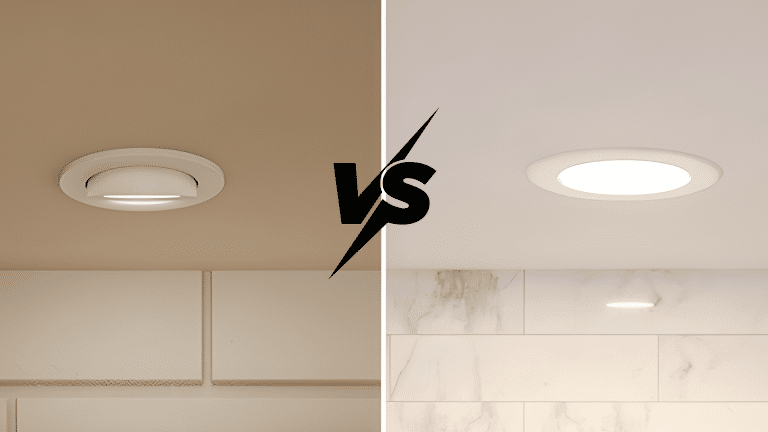Bathroom Mirror Sizing in 7 Easy Steps
I’ve seen countless homeowners struggle with choosing the wrong mirror size for their bathroom.
You spend hours picking the perfect vanity, then grab any mirror that looks about right, only to step back and realize it seems completely off.
But here’s what I learned after years of bathroom design mistakes: the right mirror size can make your bathroom look twice as big and ten times more expensive.
An appropriately sized mirror creates balance, reflects more light, and makes your daily routine so much easier.
You don’t need to be a design expert or hire a professional. I’m going to show you exactly how to calculate the perfect mirror dimensions for your specific bathroom in just seven simple steps.
Ready to get this right the first time? Let’s start measuring.
Why Mirror Size Matters in Bathroom Design?
The right mirror size can make or break your bathroom’s look and function. Small mirrors in large bathrooms feel lost and awkward. Big mirrors in tiny spaces can overwhelm the room.
Follow the Vanity Size Rule: Your mirror should match the size of your vanity. Choose a mirror that’s 2-4 inches narrower than your vanity. This creates balance and looks intentional.
Consider Light and Space. Larger mirrors reflect more light, making small bathrooms feel bigger and brighter. They also give you better visibility for daily grooming tasks.
Match Your Ceiling Height
- High ceilings: Use tall mirrors to draw the eye upward
- Standard ceilings: Wide mirrors work better
- Low ceilings: Avoid very tall mirrors
Find the Perfect Balance. The ideal mirror size strikes a balance between function and style. Measure your vanity first, then shop for mirrors that complement your existing fixtures.
How to Calculate the Size of a Bathroom Mirror?

Step 1: Measure your vanity width- Get a tape measure. Find the exact width of your bathroom vanity from edge to edge. Write this number down.
Step 2: Enter vanity measurements- Open the calculator tool. Type your vanity width into the designated input field. Double-check the number for accuracy.
Step 3: Add your ceiling height- Measure from the floor to the ceiling. Input this measurement into the calculator. This helps determine the best mirror height.
Step 4: Select your style preference- Choose from options like modern, traditional, or minimalist. Select a style that complements your bathroom’s current look and feel.
Step 5: Review the results – The calculator displays your ideal mirror dimensions. It provides recommendations for width, height, and placement based on your specific measurements.
Step 6: Compare multiple options- Try different style settings. See how various preferences change the recommended mirror size. This helps you make the final choice.
Step 7: Save or Print Results – Write down the suggested measurements. Take this information with you when shopping for your new bathroom mirror.
Mirror Dimensions Based on Vanity Width
Finding the perfect mirror size starts with your vanity measurements. The mirror should be smaller than your vanity to create visual balance and proper proportions.
| Vanity Width | Mirror Width | Mirror Height |
|---|---|---|
| 18″ | 14-16″ | 20-26″ |
| 24″ | 20-22″ | 24-30″ |
| 30″ | 26-28″ | 30-36″ |
| 36″ | 32-34″ | 36-42″ |
| 42″ | 38-40″ | 36-48″ |
| 48″ | 44-46″ | 36-48″ |
| 60″ | 56-58″ | 42-54″ |
Pro Tips for Perfect Sizing-leave 2-4 inches of vanity space on each side ,center the mirror above the vanity ,match proportions-wide vanities need wide mirrors ,consider users - tall people need taller mirrors
Choosing the Right Bathroom Mirror Shape

The shape of your bathroom mirror affects both style and function. Each shape creates a distinct mood and complements certain vanity styles and room layouts more effectively.
1. Rectangular Mirrors
Classic and versatile option that works with most bathroom styles. Provides maximum reflection area for daily grooming tasks. Perfect for standard vanities and traditional design schemes.
The straight edges create clean sight lines that make small bathrooms appear larger. It is the most cost-effective mirror shape with the widest selection of frame styles and finishes available.
2. Round Mirrors
Soft curves add visual interest to angular bathroom spaces. Creates a modern, spa-like feel that’s currently trending. Works best with floating vanities and contemporary design styles for balanced proportions.
The circular shape promotes better energy flow according to feng shui principles. Easy to clean, with smooth edges that prevent dust and grime from collecting over time.
3. Oval Mirrors
Combines the functionality of rectangular shapes with gently curved edges. Offers a timeless look that suits both traditional and transitional bathroom designs. Great for softening sharp vanity lines.
The elongated shape flatters most face shapes during daily grooming routines. Works well in narrow bathrooms where width is limited but height is available.
4. Square Mirrors
Bold geometric shape that makes a strong design statement in modern bathrooms. Works perfectly with square or rectangular vanities. Creates clean lines and a structured look for minimalist design approaches.
The equal proportions provide balanced reflection from all angles during use. Ideal for double vanity setups where matching pairs create visual harmony.
5. Arched Mirrors
Architectural detail that adds character and sophistication to any bathroom space. Perfect for traditional, farmhouse, or Mediterranean-style bathrooms. Creates visual height and draws attention upward toward the ceiling.
The curved top softens harsh angles while maintaining a functional reflection area below. Adds vintage charm that complements period fixtures and classic tile patterns beautifully.
Placement Tips for The Bathroom Mirror
Proper mirror placement enhances both functionality and aesthetics while ensuring optimal lighting and comfort for daily use.
- Center Above the Vanity- Position your mirror directly above the sink or vanity center. This creates visual balance and ensures equal light distribution on both sides of your face.
- Maintain Proper Height- Hang the mirror so the center sits at eye level for most users. Standard placement is 5-10 inches above the vanity top for comfortable viewing angles.
- Leave Adequate Side Space- Keep 2-4 inches of vanity surface visible on each side of the mirror. This prevents the mirror from looking too large and maintains balanced proportions.
- Consider Light Fixture Placement- Install mirrors before adding sconces or overhead lighting. The mirror should complement your lighting plan to minimize shadows on your face.
- Account for Multiple Users- For shared bathrooms, position mirrors to accommodate the tallest and shortest users comfortably. Consider multiple mirrors or adjustable options if height differences are significant.
Mistakes to Avoid When Selecting a Bathroom Mirror
Avoid these sizing errors that make bathrooms look unbalanced and function poorly. Poor fixture placement, inadequate clearances, and mismatched proportions create cramped, awkward spaces that feel uncomfortable and work inefficiently. Simple planning prevents costly mistakes – measure twice, plan traffic flow, and ensure proper spacing between elements before installation.
| Mistake | Solution |
|---|---|
| Mirror wider than the vanity | Keep the mirror 2-4 inches narrower than vanity |
| Tiny mirror on a large vanity | Cover 60-80% of vanity width |
| Ignoring the ceiling height | Match mirror height to room proportions |
| Wrong light placement | Plan mirror and lighting together |
| Not measuring wall space | Measure before shopping |
| Buying the cheapest option | Balance price with proper size |
| Copying other bathrooms | Use your specific measurements |
To make the process even easier, use this Bathroom Mirror Size Calculator to get personalized recommendations based on your unique bathroom dimensions.
Conclusion
Determining the right size for your bathroom mirror is straightforward when you follow the proper steps. The golden rule is to keep your mirror 2-4 inches narrower than your vanity’s width for optimal proportions.
You’ll experience better lighting distribution, improved daily use, and a cohesive design that feels professionally planned rather than haphazard. Start by measuring the width of your vanity with a tape measure.
Use established sizing guidelines to determine appropriate dimensions, factor in your ceiling height for vertical proportions, and select a shape that complements your bathroom’s style.
The contrast between a well-proportioned mirror and a poorly chosen one is significant. Correct sizing eliminates guesswork, prevents costly purchasing mistakes, and changes your bathroom into a polished, functional space that enhances your daily routine.
Frequently Asked Questions
What Is the Mirror Formula?
Mirror Width = Vanity Width – 2 to 4 inches. For height: typically 30-42 inches, depending on ceiling height and user needs.
Should Bathroom Mirrors Be Round or Square?
Choose round mirrors for a modern, spa-like feel with floating vanities. Choose square mirrors for a bold, minimalist look paired with geometric vanities. Match your style.
How Big of A Mirror for A 72-inch vanity?
For a 72-inch vanity, use a 60-66-inch wide mirror, leaving 3-6 inches on each side for balanced proportions and visual appeal.







